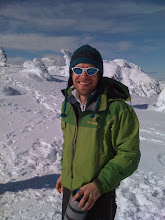Remember Gov. Palin’s sub-cabinet on climate change? Remember its Immediate Action Work Group? Well, that group is still at it, and excuse me for venturing my thoughts after observing only a few hours of a meeting this week in Anchorage, but here goes.
The IAWG seems to be undergoing some growing pains. Last year, the group’s task was fairly clear – figure out which of the expected climate-related impacts have to be dealt with immediately and deal with them. The group did that – recommending and securing about $10 million in state funds for coastal communities threatened by erosion – and with such success that it decided to continue its mission beyond that initial time period.
Now the group’s mission seems less clear. It could simply do round 2, once again identifying immediate (next 12-18 months) needs and addressing them. Or it could expand its definition of “immediate” to include more communities or more threats. The goal of the meeting Monday was partly to identify criteria by which to evaluate new requests for help.
The issue is predictably complex.
First of all, what’s immediate? The working group does have language for assessing various threats, but most of the potential threats deal with coastal erosion, which is tough to predict. Based on historical storms and impacts, dozens or even hundreds of communities are at some risk. A smaller number are at greater risk, based on sea ice trends or the proximity of infrastructure to the shore. But in most cases, there’s no way to know whether the damaging storm will come next summer or five years from now. “The variability of this is extreme,” said John Madden of the Alaska Division of Homeland Security and Emergency Management.
Second, what’s a climate impact? Scientists generally believe coastal erosion is increasing with warming temperatures and reductions in sea ice, but erosion has also been happening forever, since long before humans started changing the climate. The question of causality wasn't really an issue last year, as far as I know, but could be in the future. Officials in Ketchikan are blaming a climate-related increase in rainfall for damage to bridges, and officials in White Mountain point to climate change to explain falling river levels, bark beetle damage, and drying soils.
The challenges point to another, larger question the state will have to answer at some point – whether to respond to climate-related threats separately, or through an effort integrated within its departments. Last year, the IAWG addressed a need that was clearly not being met – a wide range of residents and government officials publicly testified to the lack of coordinating agency on the issue of coastal erosion. Things like wildfire management and bridge replacement, on the other hand, already fall under the purview of specific state departments, even if the factors influencing them are changing. The IAWG risks becoming an attractive funding option for local governments or departments frustrated with the slow arrival of cash for priority projects.
I don’t mean to suggest the IAWG is lost at sea. Its latest report – available in draft form on its Web site – is an impressive document.
In one sense, attributing the risks to climate change doesn’t really matter. Coastal erosion and wildfire threats must be addressed regardless of the cause. Extra funds could simply be added to departmental budgets for dealing with new challenges. And encouraging departments to plan for a changing climate seems easier than having a group of climate experts identify climate-related threats across all arenas, from infrastructure to fish and game.
The question of attribution is also complex – are community leaders really in a position to judge what’s causing a given threat? Figuring out if climate change is behind the erosion in a specific village would require at least a soils expert, a cryologist, an atmospheric scientist, and a roomful of elders.
But if the state wants to get serious about addressing climate change, creating a public awareness of its tangible costs would probably help. Imagine the impact of a budget line reading, “Projects for dealing with climate change - $100,000,000.” (Separate groups within the sub-cabinet are already looking at adaptation and mitigation measures.)
But that’s the big picture. At the meeting Monday, the IAWG was trying to figure out what to do in the next few months, mostly with coastal erosion. First there’s the question of which communities are at most risk. Then there’s the question of which projects will best address those risks, and whether it makes sense to invest in communities that may soon be forced to move.
Members seemed engaged and committed to their task, but I can imagine being overwhelmed by the complexity of the issue and the responsibility of assessing threats to life and infrastructure and allocating resources accordingly.
At one point, officials from a few villages were given the chance to testify. Over a scratchy phone connection, many hundreds of miles away, one tried to explain why his village was in danger and they needed money now. He spoke English, of course, but it wasn’t clear he was getting through. The IAWG consulted for a minute and decided he should apply for a specific grant. Just what he wanted to hear, I’m sure.
Subscribe to:
Post Comments (Atom)

No comments:
Post a Comment